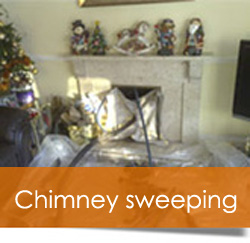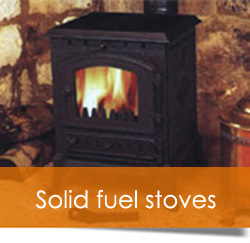
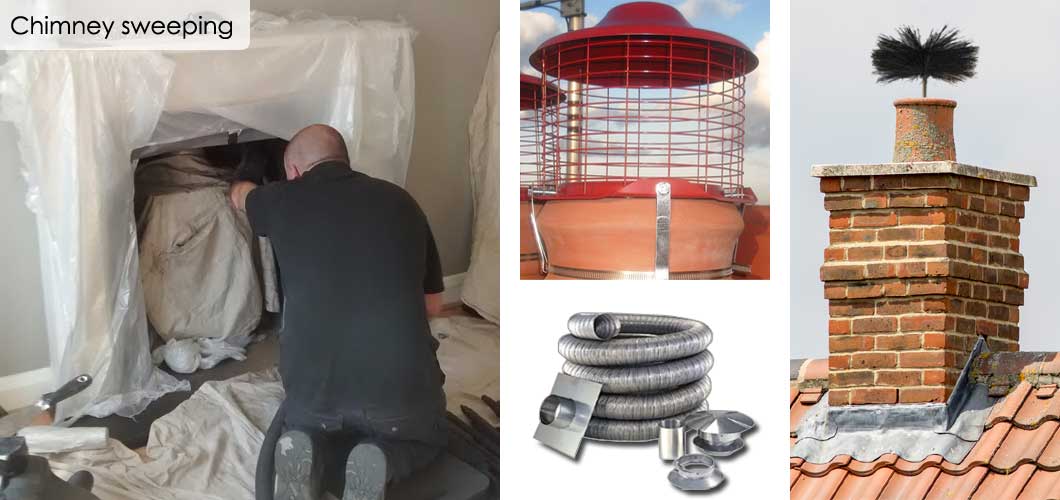
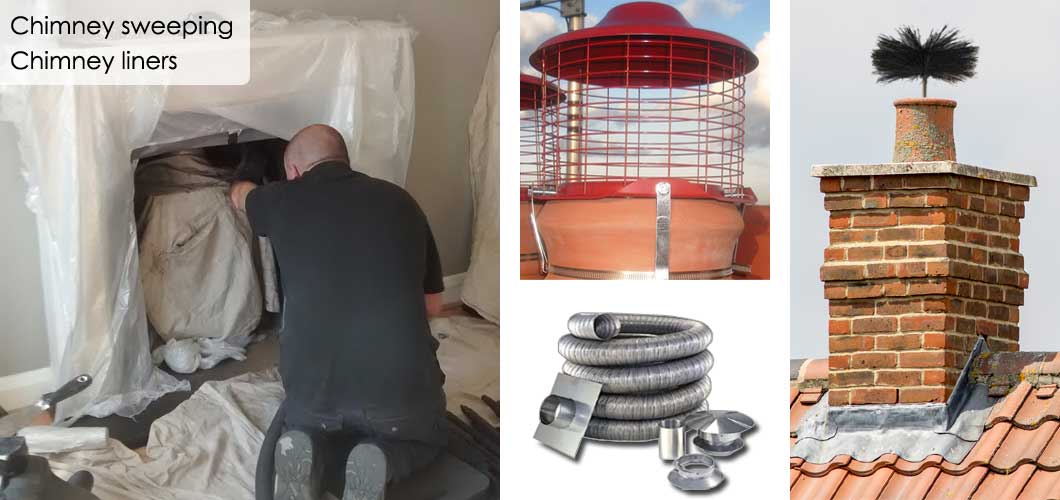
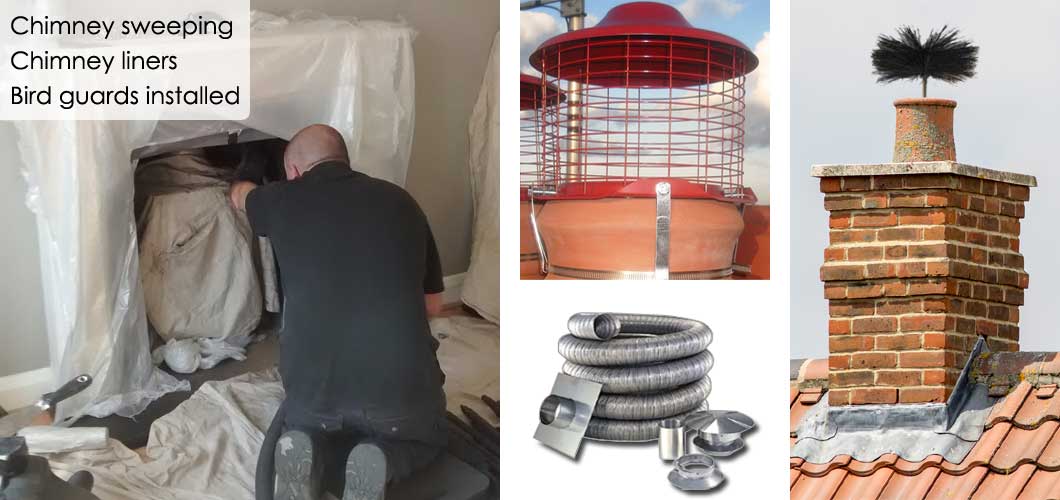
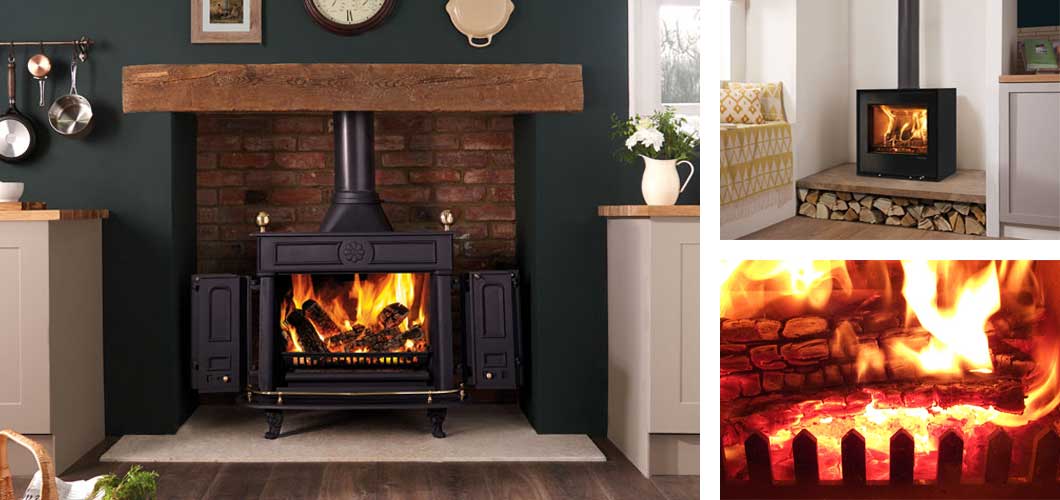
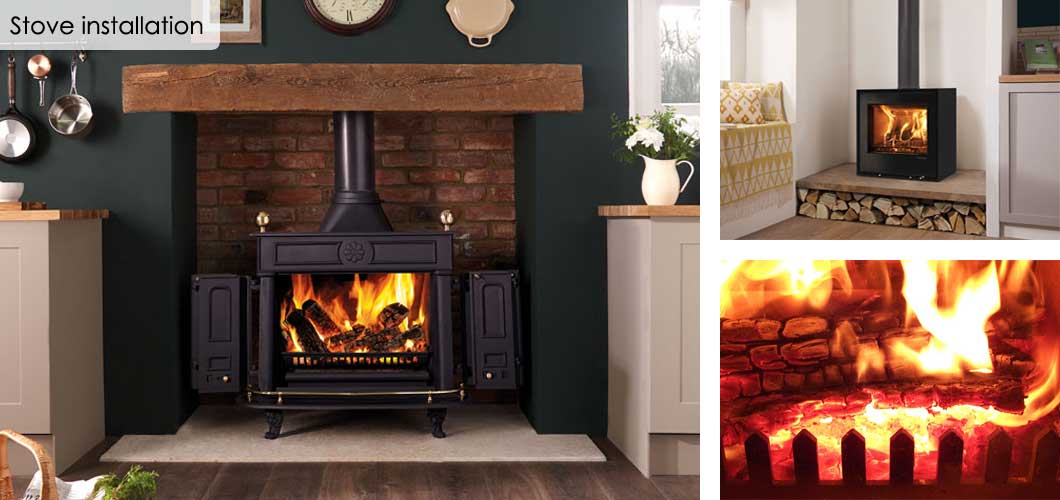
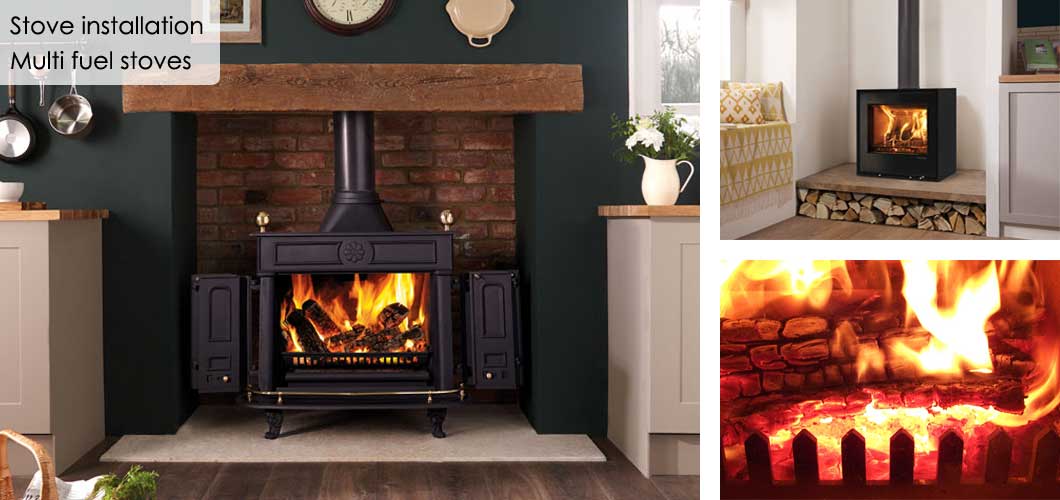
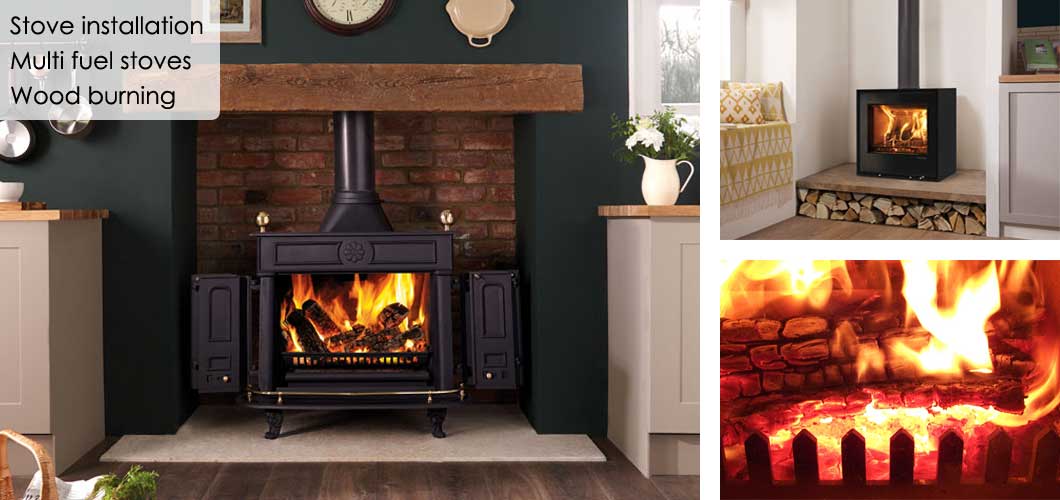


























Chimney Sweep services in Watford, Hertfordshire
At Ansell Chimneys, we know how important it is for you to keep your chimney in tip top working order. It's not just a case of good housekeeping, it could save lives! So don't risk letting your chimney get clogged up and dangerous, call the professionals in today!
Our services include:
- Chimney Sweeping
- Installation of chimney liners
- Chimney Pots, Bird guards and Cowls
- Camera surveys
- Fitting wood burning and multi-fuel stoves
- Stove and fireplace servicing and repairs
- Chimney Smoke and integrity testing to BS5440
All installations carried out by
Qualified HETAS Registered Fitters.

Why not call Ansell Chimneys now for a free quote
If you would like to know more or are interested in a quote we would be happy to help. Phone us on 01923 661 614, email us at info@ansellchimneys.co.uk or fill in our enquiry form and we will be in touch as soon as possible.
Ansell Chimneys for service you can trust
No matter where you live, if you have an open fire or a solid fuel stove, you will need to engage the services of a chimney sweep. Many of the properties in and around Watford have working chimneys, unlike some new builds that have facade chimneys that serve no actual function. Clearly a facade chimney will improve the aesthetic appearance of a dwelling, but as it serves no actual working purpose, it will never require sweeping.
A Watford chimney sweep to keep you safe
A chimney that is not regularly swept can literally become very dangerous indeed. When wood burns, creosote is deposited on the inside of the chimney. The creosote can easily catch fire, putting you, your family and your property at serious risk.
Other obstructions can also cause serious issues. Nesting materials and debris from trees can also cause blockages that may prevent the fire drawing correctly, causing a build-up of carbon monoxide inside the home, which can often prove fatal.
As Watford has a good supply of trees in residential areas, it is vital to engage the services of a reputable chimney sweep and ensure they call on a regular basis.
What is a chimney sweep?
A chimney sweep is a person who clears ash, soot and other obstructions from chimneys. The chimney uses the pressure difference caused by a hot column of gas to create a draught and draw air over the hot coals or wood enabling continued combustion. Chimneys may be straight or contain many changes of direction. During normal operation, a layer of creosote builds up on the inside of the chimney, restricting the flow. The creosote can also catch fire, setting the chimney and the building alight. The chimney must be swept to remove the soot. This work is done by the chimney sweep.
So many things require attention from time to time. The oven needs a clean, as do the windows; we may even give the patio a good blast with the pressure washer once during the colder months to clean away the nasty green algae that has built up, but some things seem to be forgotten about.
The most overlooked household maintenance task that is frequently overlooked could potentially be the one job that could save your life. We are talking about the chimney being swept!
Chimneys do need to allow the free passage of combustion gasses, as these can be very dangerous. Regular chimney sweeping removes soot and any other items that could obstruct the flow such as bird and squirrel nests. Sweeping the chimney also removes creosote, and this will help to prevent chimney fires, as the creosote is highly flammable. Chimney Sweeping will increase the efficiency of many heating appliances too.
Chimney sweeping frequency
How often you have your chimney swept will depend on a number of factors which include the type of fuel you burn, the type of heating appliance used, how long it's used for, the moisture content of wood you burn, and the type of chimney you have. Our Watford chimney sweeps can offer you expert advice on how often you have your chimney swept during the initial appointment.
As a rough guide to sweeping frequency, you should be looking to have a smokeless fuel fire swept at least once a year, a wood burner fire requires quarterly sweeping, as does a coal fire. Oil and gas fuelled fires generally dictate a professional chimney sweeping be carried out once a year.
A professional chimney sweep in Watford
Owing to the nature of the work, and the potential hazards involved, we strongly recommend using a professional chimney sweep to carry out the work on your Watford home.
Chimneys can be messy
When you consider the by-products of fires, it is easy to see that what comes out of your chimney could make a bit of a mess. However, our chimney sweeps are very careful and work methodically to minimise the amount of soot and creosote that are removed from the chimney itself. We always do our best to make as little mess as possible, and do everything in our power to prevent dust escaping into your room during the sweeping process. Of course, there may be occasions where more mess could be a factor, such as if a nest has caused a blockage in the chimney.
Before we visit your Watford home
Before your appointment with us, please try to ensure we have adequate space to work in. Any furniture or ornaments on the hearth or fireplace should be removed to a safe location. It would also be helpful if the grate could be cleared of any fuel, ash or rubbish prior to our arrival.
We will always do our best to ensure a clean work environment and we always carry protective dustsheets for carpets, floor surfaces and furniture.
Do gas appliances need sweeping?
Although Watford has many properties with solid fuel fires and stoves, many also have appliances that are supplied with natural gas. Although gas does not normally deposit soot, there are still numerous other problems, which can affect chimney function which regular sweeping can solve or identify. It could also help with the prevention of chimney fires and even carbon monoxide poisoning. Many gas fires have to be isolated owing to a chimney that is not drawing correctly, as the last thing you want is the fumes from gas fired re-entering the room.
Having your chimney swept in a new house
You may have just moved to a new house in Watford and are wondering if you should have the chimney swept. So many homeowners have neglected to have this done, as the mind-set appears to be, 'new house, new fire!'
Think about it, simply because you have not used the fire, does not mean that the previous owners had not used it daily prior to you moving in. So having your chimney swept as a precaution when you buy a house is a very wise move.
Types of fuel for open fires
The type of appliance you have will more often than not dictate the type of fuel that should be used. Clearly, you would not try to burn wood in a gas fire, so check what fuel type your appliance is designed to burn.
Wood that has been properly seasoned is commonly used as it is clean, gives good heat and is carbon neutral. Just ensure that the wood has the correct moisture content. The moisture content of properly seasoned firewood should be under 20%, as firewood burns most efficiently between moisture content levels of 15% and 20%. Seasoned firewood typically will not drop lower than around 10% moisture content because of the humidity of the atmosphere.
However, some people prefer using coal as it suits them better. If you are thinking of using coal, then we recommend you use a local approved coal merchant who will have the expert knowledge to guide you, but beware! Time is fast running out if you want to burn coal. From May 2023, people with open fires can still use coal until that date provided they do not live in a smoke control area and purchase it from their local approved coal merchant.
Remember that some areas of the United Kingdom are smoke free zones, which must also be taken into consideration when selecting fuel.
Chimney sweeping before closing off a chimney
You may decide that you want to stop using a solid fuel in your Watford home and thus no longer need an operational chimney. Should a chimney no longer be needed, they can be closed off. Be aware that if a chimney is closed off, it can become damp. If there is soot present in your chimney, it can turn into a black acidic soot deposit that in an old chimney can soak into the internal walls, causing serious issues to the decor. If the damp gets particularly bad, then it can penetrate the wall into the room where it will cause unsightly stains on the walls, ruining wallpapered and painted surfaces.
Do you have marks above your fireplace?
These marks may be caused by smoke from your fire leaking back into the room. This is a telltale sign that something is wrong and you should stop using your fire immediately, as the dangers of the exhaust fumes coming back into the room cannot be understated.
Should you see any marks, streaks or even experience an unpleasant smell or headaches, please call us as a matter of urgency. Above all, please stop using your fire until a professional chimney sweep has called and either rectified the problem, or offered suitable advice.
Preventing unwelcome visitors and blockages to your chimney
Birds, squirrels and leaves from nearby trees are all a major pain with an unprotected chimney.
Bird cowls are a simple and effective way of preventing the incursion of our feathered friends when they are searching for a suitable nesting site. Not only can the remains of their nests cause blockages, birds, particularly the young can become stuck in the chimney. The smell from a decomposing bird in your chimney can make the entire house smell awful for a considerable period.
We can offer advice and practical solutions for your Watford home to keep these issues at bay.
History of the chimney sweep
Many years ago, a master chimney sweep would often take on a boy as his apprentice. This practice was not only common in the big cities, but in smaller towns such as Watford. In fact, you would see more of these young lads in areas close to workhouses.
In Great Britain, the master sweeps took apprentices, these were typically workhouse or orphan boys, and trained them to climb chimneys. In the German States, master sweeps belonged to trade guilds and did not use climbing boys. In Italy, Belgium, and France climbing boys were used. These boys would often climb naked to save damaging the clothing that their master had bought. Their skin would be cut and bruised as a result. Some climbing boys died after falling or becoming stuck and suffocating in the chimney.
With the increased urban population that came with the age of industrialisation, the number of houses with chimneys grew apace and the occupation of chimney sweep became much sought-after.
Buildings, particularly in urban areas such as Watford were higher than before and the new chimney tops were grouped together. The routes of flues from individual grates could involve two or more right angles and horizontal angled and vertical sections. The flues were made narrow to create a better draught, 14 inches by 9 inches being a common standard. Chimney sweeping was one of the more difficult, hazardous, and low paid occupations of the era, and consequently has been ridiculed in verse, ballad and pantomime.
The first mechanical sweeper was invented by George Smart in 1803 but was resisted in the United Kingdom and the United States. Joseph Glass marketed an improved sweeping machine in 1828; he is credited with being the inventor of the modern chimney sweeps brush. In the northern United States, white sweeps gave up sweeping themselves and employed black sweep boys from the South to carry out the task instead. After regulation finally took hold in 1875 in the United Kingdom and the turn of the century in the United States, the occupation became romanticised in popular media.
Chimney sweeps in Great Britain
The practice of using a climbing boy of about ten years old was common. The boys would climb by bracing their back and knees against the chimney. Sometimes the boys would become stuck, with their knees are wedged up against their chin. With their body blocking the chimney and unable to move up or down, the boys often died from asphyxiation or burn to death. Sometimes a second boy would be sent to help, and on occasions would suffer the same fate. Boys as young as four climbed hot flues that could be as narrow as 9 by 9 inches. Boys as young as four were sometimes used to climb hot flues that could be as narrow as 9 by 9 inches.
The first known industrial cancer
As soot is carcinogenic, and as the boys slept under the soot sacks and were rarely washed, they were prone to chimney sweeps carcinoma. From 1775 onwards there was increasing concern for the welfare of the boys, and Acts of Parliament were passed to restrict, and in 1875 to stop this usage. Lord Shaftesbury, the philanthropist, led the later campaign.
Chimney sweeps carcinoma, which the sweeps called soot wart, did not occur until the sweep was in his late teens or twenties. It was first reported in 1775, making it the first industrially related cancer to be found.
When chimneys first appeared
Chimneys started to appear in Britain around 1200. Before this there was an open fire burning in the middle of the one room house. At first there would be one heated room in the building and chimneys would be large. Over the next four hundred years, rooms became specialised and smaller and many were heated. Sea coal started to replace wood, and it deposited a layer of flammable creosote in the inside surface of the flue, and caked it with soot. Whereas before, the chimney was a vent for the smoke, now the plume of hot gas was used to suck air into the fire, and this required narrower flues.
Young boys rarely climbed chimneys before the Great Fire of London, when building regulations were put in place and the design of chimneys was altered. The new chimneys were often angular and narrow, and the usual dimension of the flue in domestic properties was 9 inches by 14 inches. The master sweep was unable to climb into such small spaces himself and employed climbing boys to go up the chimneys to dislodge the soot. The boys often 'buffed it', that is, climbed in the nude, propelling themselves by their knees and elbows which were scraped raw. They were often sent up hot chimneys, and sometimes up chimneys that were alight in order to extinguish the fire. Chimneys with very sharp angles posed a particular hazard to the unfortunate lads.
From about 1803, there was an alternative method of brushing chimneys, but sweeps and their clients resisted the change, preferring climbing boys to the new humane sweeping machines. Compulsory education was established in 1870 by the Education Act 1870 but it was a further five years before legislation was put in place to license chimney sweeps and finally prevent boys being sent up chimneys.
An apprenticeship like no other
The climbing boys, and sometimes girls, were technically called chimney sweeps apprentices, and were apprenticed to a master sweep, who, being an adult, was too large to fit into a chimney or flue. He would be paid by the parish to teach orphans or paupers the craft. They were totally reliant on him: they or their guardians had signed papers of indenture, in front of a magistrate, which bound them to him until they were adults. It was the duty of the Poor Law guardians to apprentice as many children of the workhouse in their care as possible, so as to reduce costs to the parish. The master sweep had duties: to teach the craft and its mysteries, to provide the apprentice with a second suit of clothes, to have him cleaned once a week, allow him to attend church, and not send him up chimneys that were on fire. In return, the apprentice agreed to obey his master. Once his seven yearlong apprenticeship was completed, he would become a journeyman sweep, and would continue to work for a master sweep of his choice. Other apprentices were sold on to the sweep, or sold by their parents.
It was generally agreed that six was a good age to train a boy. Though Lord Shaftesbury once encountered one of the age of four, they were considered to be too weak. A master sweep would have many apprentices, who would start the morning by roaming the streets calling out "Soot -Oh, Sweep" or another cry to let the local residents know they were around; this would remind the owners of the dangers of un-swept chimneys. When engaged, the master sweep would fix a cloth over the fireplace, and the climbing boy would take off his boots and any excess clothes, then get behind it. The flue would be as tall as the house and twist several times, and its dimensions would be 14 inches by 9 inches. He would pull his cap down over his face and hold a large flat brush over his head, and wedge his body diagonally in the flue. Using his back, elbows and knees, he would shimmy up the flue and use the brush to dislodge loose soot, which would fall over him and down to the bottom, and a scraper to chip away the solid bits, as a smooth chimney was a safe chimney. Having reached the top, he would slide back down at speed back to the floor and the soot pile. It was now his job to bag up the soot and carry it back to the master sweep's cart or yard.
Soot was considered valuable and could be sold for 9d a bushel in 1840. An apprentice would do four or five chimneys a day. When they first started, they scraped their knees and elbows, so the master would harden up their skin by standing them close to a hot fire and rubbing in strong brine using a brush. This was done each evening until the skin hardened. The boys got no wages but lived with the master, who fed them. They slept together on the floor or in the cellar under the sacks and the cloth used during the day to catch the soot. The boy would be washed by the mistress in a tub in the yard; this might happen as often as once a week, but rarely. One sweep in London used to wash down his boys in the Serpentine. Another Nottingham sweep insisted they washed three times a year, for Christmas, Whitsun and the Goose Fair. Sometimes, a boy would need to be persuaded to climb faster or higher up the chimney, and the master sweep would light either a small fire of straw or a brimstone candle, to encourage him to try harder. Another method to stop him from asphyxiating was to send another boy up behind him to prick pins into his buttocks or the soles of his feet.
Chimney sweep boys in peril
Often the chimney would still be hot from the fire, and occasionally it would actually be on fire. Occasionally climbing boys could get stuck with their knees jammed against their chins. The harder they struggled the tighter they became wedged. They could remain in this position for many hours until they were pushed out from below or pulled out with a rope. If their struggling caused a fall of soot they would suffocate. Dead or alive the boy had to be removed and this would be done by removing bricks from the side of the chimney.
Health and safety concerns for the sweep boys
The conditions to which these children were subjected caused concern and societies were set up to promote mechanical means for sweeping chimneys. Their treatment was so bad that should one die, the Coroner's Jury would most likely return a verdict of "Accidental Death".
These however were not the only occupational hazards that chimney sweeps suffered. In the 1817 report to Parliament, witnesses reported that climbing boys suffered from general neglect, and exhibited stunted growth and deformity of the spine, legs, and arms, which were thought to be caused by being required to remain in abnormal positions for long periods of time before their bones had hardened. The knees and ankle joints were the most affected. Sores and inflammation of the eyelids that could lead to loss of sight, were slow in healing because the boy kept rubbing them. Bruises and burns were obvious hazards of having to work in an overheated environment. Cancer of the scrotum was found only in chimney sweeps so was referred to as Chimney Sweep Cancer in the teaching hospitals. Asthma and inflammation of the chest were attributed to the fact that the boys were out in all weathers.
The situation today
Fortunately, we no longer subject young children to these sorts of horrors, but much of the manual work methods have remained the same. Creosote is still a threat as are nesting materials and other debris lodged in the chimney.
Why not call Ansell Chimneys now for a free quote
If you would like to know more or are interested in a quote we would be happy to help. Phone us on 01923 661 614, email us at info@ansellchimneys.co.uk or fill in our enquiry form and we will be in touch as soon as possible.
Ansell Chimneys
t. 01923 661 614 | m. 07941 282 325 | m. 07976 318 160 | Email us
t. 01923 661 614
m. 07941 282 325
m. 07976 318 160
Email us
Abbots Langley | Bricket Wood | Bushey | Chorleywood | Croxley Green | Elstree | Hemel Hempstead | Kings Langley | Radlett | Rickmansworth | South Oxhey | Stanmore | St Albans | Watford
Abbots Langley | Bricket Wood | Bushey | Chorleywood
Croxley Green | Elstree | Hemel Hempstead | Kings Langley
Radlett | Rickmansworth | South Oxhey | Stanmore
St Albans | Watford





